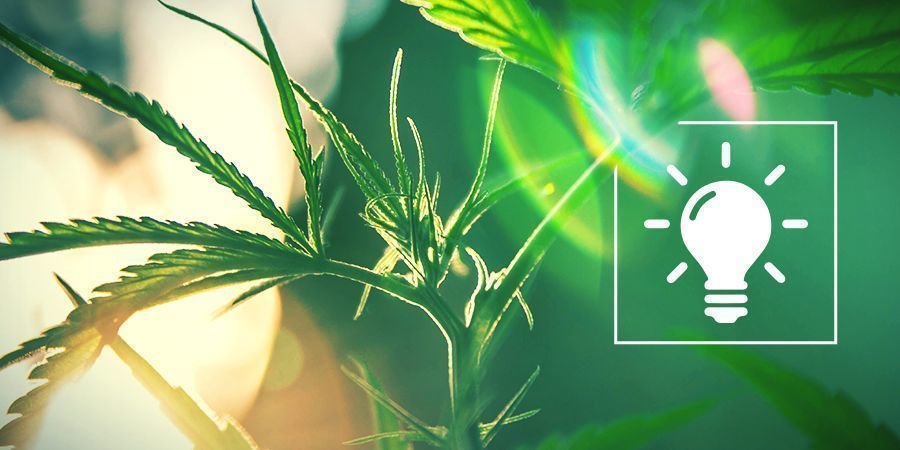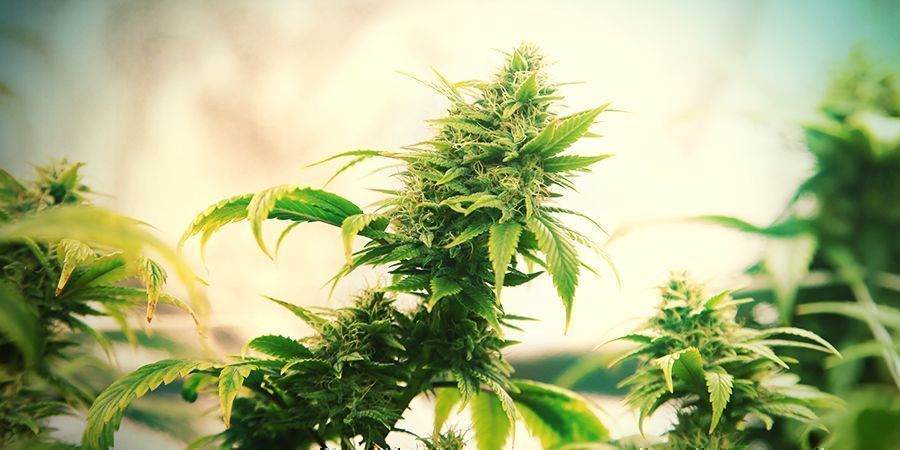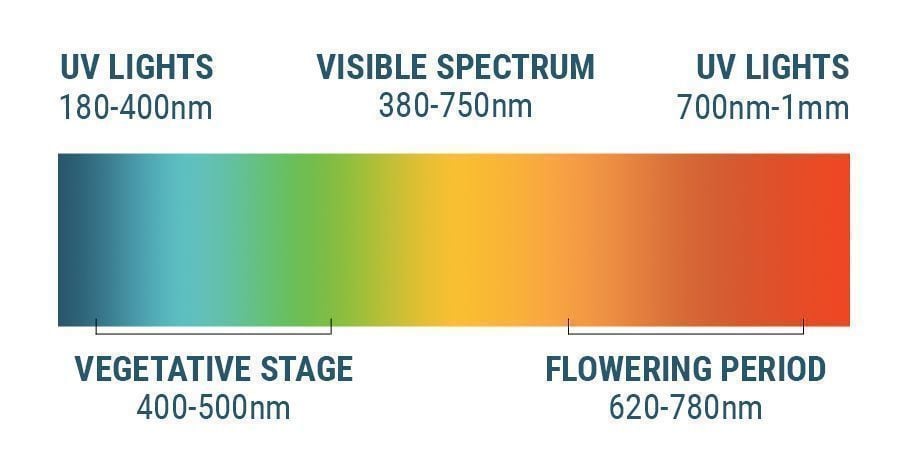Choosing The Right Light For Your Grow-Op

Cannabis plants have many demands, but none quite as important as lighting. A good set of lights are needed to ensure plants can photosynthesise properly and make enough energy to survive and thrive.
Moreover, growers need to make sure they are running the correct lights for each phase of the growing operation. This can make the difference between an average yield and an exceptional one. Learn what kinds of lights are available and which type will work best for your particular grow.
Artificial lighting is the backbone of any indoor cannabis growing setup. Light is the driving force behind essential plant functions like photosynthesis and transpiration. Light intensity, spectrum, and positioning each play a role in efficient light use for general plant vigour. Manipulating the photoperiod during each phase of the cannabis grow cycle is essential for successful vegetation and flowering.
TYPES OF LIGHTS FOR GROWING CANNABIS
There are a number of lighting systems available to grow cannabis. The demand for high-quality indoor cannabis has largely been the driving force behind recent developments in lighting technology. The last two decades have seen the introduction of CFLs, high output fluorescent tubes, customisable spectrum LED, and super efficient digital ballasts. Knowing the characteristics of each light type can help you make an informed decision for your grow.
1. HIGH-INTENSITY DISCHARGE (HID)
.jpg)
HID lights have long been the standard for cannabis growing. The greater the lumen output, the better the plant response. In essence, you are trying to replicate the sun, which comes in at around 100,000 lumens per m². The upside of HID lamps are their strength and coverage. The downside is they generate a lot of heat in two ways; the lamps themselves cast heat, and the ballasts used to regulate voltage also generate heat. Excellent exhaust and air circulation is always a must with growing cannabis. Even more so when using HID lighting systems.
HIGH PRESSURE SODIUM
HPS lights are the all-round performers of HID style lights. They can be used to great effect during the whole grow. They function by passing an electrical current through a gas-filled bulb. The inert gas xenon is mixed with sodium and mercury vapour. These glow to produce the well-known yellowy/orange-tinged light seen in so many grow-ops. The predominantly yellow/orange light spectrum is strong at 2200K and is ideal during the flowering phase.
METAL HALIDE
MH lights are equally as efficient at growing cannabis as HPS. Similarly, they function by passing an electrical current through a gas-filled bulb. This time, the gas contains metal halides, which are compounds of metals with bromine or iodine. The light is noticeably blue/white in comparison, yet will still produce excellent results from seed to harvest. The blue spectrum is ideal for photosynthesis and performs best on vegetative plants.
If you have the resources, vegetating cannabis under MH achieves best results during the 18-6 photo cycle. Then, swap the bulbs out for HPS at the 12-12 flip to the flowering phase. In this way, the changing light spectrums that occur in nature are imitated. Seasons change from spring/summer conditions:
- Blue light
- High-UV
- Long days
- Vegetation
To autumn/winter conditions:
- Yellow/orange light
- Low-UV
- Short days
- Flowering
Each light should perform faultlessly to produce great weed from start to finish. Changing bulbs and spectrums from veg to flower gets optimal results.
INTENSITY IN GROW TENTS

HPS & MH lights come in a range of wattages and globe styles. The higher the wattage, the more intense the light over a larger area, with deeper penetration into the plant structure. Only your experience can really guide you on this decision. Popular among marijuana growers are:
150W
- Coverage: 0.6m x 0.6m, 1-3 plants.
- Light to canopy: 17cm
- These smaller HID lights often have built-in ballasts and can simply be plugged into a socket. Dedicated exhaust is usually unnecessary. The implicitly small space will be well-ventilated by the vigorous airflow needed for cannabis to thrive.
250W
- Coverage: 0.8m x 0.8m, 3-5 plants
- Light to canopy: 25cm
- More wattage means more heat. Lights with built-in ballasts will need to have their heat output assessed for appropriate ventilation. Models with external ballasts are easier to keep cool by keeping the ballast out of the grow space.
400W
- Coverage: 1.0m x 1.0m, 6-9 plants
- Light to canopy: 30cm. If it is hot on the back of your hand, it is hot on your plants. Common sense will always prevail.
- Lights with built-in ballasts will certainly need to be exhausted. This is entering the real heat-generating wattage range now. Remember, cannabis likes to stay below 27°C, and 400W is a little heater in an enclosed space.
600W
- Coverage: 1.2m x 1.2m, 9-12 plants
- Light to canopy: 40cm
- Really powerful growth begins in this higher wattage range. So do the ventilation needs of your grow space. If your light does not have dedicated exhaust built-in, it will certainly need a cooling strategy. Don’t scrimp on the ventilation and exhaust, they are of exceptional importance for healthy cannabis (and not burning down your house).
1000W
- Coverage: 1.5m x 1.5m, 12-16+ plants
- Light to canopy: 53cm minimum. The “too-hot-for-your-hand-is-too-hot-for-plants” rule applies more than ever now.
- Lights of this wattage and beyond are the international standard for professional grow setups with plenty of room. You are going to notice that power bills are bigger and the heat generated can raise room temps by 25°C. Lots of air movement in the room and deliberate exhausting of heat is of utmost importance. Cool tubes are a good investment. They are a ventilated, transparent fitting that exhausts the heat directly from the bulb surface. Depending on geographical location, temperature control like air conditioning may be needed.
Plant numbers are dependant on growing style. Fewer or even just one for a ScrOG or more for a SOG. Then there are all the in-between defoliating techniques. At all wattages, even canopies and thorough light penetration promote the best response from cannabis.
2. COMPACT FLUORESCENT LIGHTS (CFL)
-2.jpg)
CFLs are the low-temperature, minimal grow space, limited available height solution for the marijuana hobbyist. This style of light is reasonably priced and readily available in hardware stores and supermarkets. They have a very cannabis-friendly light spectrum and come in daylight (6500K) for vegetation and soft white (2700K) for flowering.
Cannabis will grow under any wattage on the correct light cycle. However, there is growing and there is growing. Less wattage means less everything during each growth phase. A few calyxes struggling into existence under a 13W light seems like a lot of effort for very little gain. There is just no shortcut to lots of light. You are the sun.
Aim for 150W per plant. This can be configured in a number of different ways as CFL wattage ranges from low at 13W to high at 200W. With CFL grows, cannabis responds better to many lower-wattage bulbs up close (10cm) and distributed evenly. One large, high-wattage bulb tends to cast unwanted shadows. As with all lights, the intensity decreases inverse to the square of the distance from the light source. When the original light source is meagre to begin with, the 1~(1/r²)[1] rule means darkness to a plant at 35cm from a CFL.
Specialised fittings with multiple battens are available that efficiently distribute available wattage per m². The battens are equally spread around a central node and distribute the light evenly.
Some extra attention needs to be paid with a CFL grow:
-
Low stress training and defoliation techniques are well-suited to the CFL grow. The lights need to be close to the plant and barely penetrate the canopy. Lollipopping and main-lining are particularly suited to CFL light setups. If you can throw extra money at your grow, then supplementary lighting at the sides can help increase growth in the understorey.
-
Plants need to be checked fastidiously. Marijuana grows rapidly and will get too close to the lights quite quickly. When plants get too close to any kind of light source, including CFL, they slow their growth. Keeping the lights at the optimal distance (10cm) ensures best growth at all times.
-
Check grow medium conditions often. Evaporation and transpiration are minimal with a CFL grow. This risks nutrient and pH buildup or interrupting the wet dry cycle. Keep a keen eye on growing conditions.
-
Make sure there is plenty of air movement at all times. Even when lights are out. Unaddressed shadows can harbour pathogens.
3. LIGHT-EMITTING DIODE (LED)
.jpg)
LEDs are quickly becoming the darlings of the cannabis growing world. With added bonus configurations that include infrared and ultraviolet options, the LED setup offers a select variety of spectrums. They are power-efficient and run considerably cooler per lumen emitted than HID lights.
Unlike HID and fluorescent lights which pass a current through a gas, the LED uses different technology to produce light. A diode is a two lead semiconductor circuit element that only allows a charge to flow in one direction. When the necessary charge or bias is applied, the material of the diode emits light. LEDs can include lenses and other integrated components. These little treasures are used comprehensively in the electronics and information industries, and are becoming the standard for auto headlights.
LED chipsets are usually 3W or 5W bulbs arrayed on panels to give different intensities. For example, a 125W LED panel will have 25 x 5W LED chipsets. To provide a cannabis-friendly spectrum, different coloured bulbs are available. The panels can have blue, red, white, UV, and infrared bulbs in different configurations for vegetation and flowering. Blue spectrum, high-UV for vegetation and red spectrum, high-infrared for flowering. (When using exotic spectrums like infrared, use protective tinted glasses when inspecting your plants. These unseen wavelengths can damage your retinas).
LED panels have the attraction of being more cost effective to run in a number of ways. Initial setup costs are comparative to HID and continue to decrease as demand grows and the tech gets cheaper.
Energy efficiency is where the LED setup will be most noticeable. HID lamps waste 95% of their energy as heat. LED panels waste far less of the same. In this way, they can be cooled more effectively with onboard fan setups and heat sinks. Heat is radiated away from the plant canopy and is mediated more easily with vigorous ventilation.
They use substantially less power to operate and you will notice a 40% reduction in your power bills. One reason is LED lights are bright the moment they are turned on. Other light sources require a warm up period before they are operating at spec. An LED panel also produces more lumens per watt than other lighting alternatives.
They last 50-60,000 grow hours while HPS has a functional life of 2-3,000 grow hours.
The LED arrangement focusses light on the canopy without the need for added costs like reflectors. All of the other light types require reflectors to redirect the light that would otherwise escape towards the ceiling.
Although LEDs produce substantially less heat, they still produce enough photon energy to burn your plants. Don’t let the pretty purply spectrum fool you. Placing LED panels closer than 30-45cm will burn your plants just as thoroughly as an HID lamp of any kind.
THE LIGHT SPECTRUM AND CANNABIS

The sun is the template for the indoor grower. It provides a complete spectrum of radiation, from one far end of the invisible spectrum where X-rays lurk, to the complete visible spectrum.
You as light source only need supply the visible spectrum and a few others to grow cannabis successfully. All those other waves and particles are passing through everything, including you and your grow anyway.
Cannabis requires a range of spectrums of light to fulfil its genetic potential. We all experience these spectrums as light in general. The light spectrum can be seen changing from sunrise to sunset and during the seasons as the sun moves through the sky.
Plants respond to these spectrums in different ways. Outdoors, these spectrums are seasonably linked, while indoors, the conditions can be mimicked. Response to light spectrum is an artifact of evolution in plants that can be exploited to increase yields indoors.
During the natural vegetative phase of cannabis, which is spring through summer, the sun rises rapidly and is high in the sky for longer periods of time. With little atmosphere to penetrate, the light trends towards blue/white and is high in UV radiation. The indoor grower endeavours to mimic this light as much as possible. The day length is imitated as the 18-6 vegetative photoperiod. This tells your plant it is spring and thus, time to put on volume and make lots of roots.
Indoors, these spring/summer conditions can be conjured using MH lights for vegetation, cool-coloured CFLs, or LED panels with a predominance of blue bulbs.
During the natural flowering phase of cannabis, which is late summer through autumn, the sun rises more slowly as the seasons progress and is lower in the sky for shorter amounts of time. With more atmosphere to penetrate, the light is more yellow/red and is high in infrared radiation. The photoperiod is shortened to 12-12 to imitate the shorter days. This tells your plant it is autumn - time to stop vegetation and begin flowering.
Indoors, these autumnal conditions can be resurrected using HPS lights for flowering, warmer-coloured CFLs, or LED panels with a predominance of red bulbs.
It seems like a lot of information to process. The intricacies of light are just one of the elements in the witches brew of information that is growing good weed. Knowledge about lighting, plant nutrition, the importance of water quality, air circulation, and temperature, as well as a bit of gardeners patience, time, and a few online tutorials like this one will build you into the world-class grower of cannabis you aim to be.














 United States
United States










